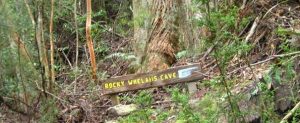 Ok, I know, this doesn’t look like a convict – but it’s the closest I could get to Rocky – Rocky Whelan, that is. In 1855, the notorious bushranger John Rocky Whelan had one of his hiding places on the east face of Mount Wellington, as well as another bolt hole near Kingston. On May 19th 1855 Rocky Whelan was arrested in Hobart and was found to have on him a double-barrelled pistol primed and ready to fire, as well as £16 in cash. Having the cash alone would have put Rocky under suspicion, as he had no reputation for being a hard worker as a convict and could never have earned that much. Besides which, at the time of his arrest, he was an escaped convict, which means if he had any cash on him he must have stolen it. Added to that he was found in possession of the boots of a man who had been missing, presumed dead for some months. John Rocky Whelan was a big man for his times, standing at 6’1” and of heavy build, and was named Rocky for the crags and deep pock marks of his face. Rocky had been sentenced to transportation from England and arrived in Sydney in 1829. He escaped from the custody of the Crown and took to highway robbery for which he arrested and tried in Sydney, then transported to Norfolk Island, where he was involved in the unsuccessful taking of the brig “Governor Phillip.” For these crimes Rocky spent a total of eighteen years on Norfolk Island after which, in 1854 he was sent to Hobart and was assigned to the public works gang. He only lasted two days before he absconded again, this time into the rugged bushland of Mount Wellington which stands over Hobart. While living up on Mount Wellington one winter, Rocky was known to have called in at the home of a local magistrate and on snowy winter nights would sit in the back of the kitchen by the fire and read the Gazette. The purpose of these reading sessions was to discover if the authorities had as yet published a correct verbal description of him. The evening when Rocky read his clear description in the Gazette was the last the land-owning magistrate saw of him. The magistrate did not make any attempt to report these visits from Rocky, knowing the consequences of his actions. After all, the settler was a magistrate, not a policeman and knew better than to put at risk the lives of himself and his family. Rocky was arrested by chance, many months after a Mr Dunn was reported missing. Rocky was in a boot maker’s in Hobart and had left the worn out boots of one of his victims – Mr Dunn – at the door of the shop. An eagle-eyed constable spotted the boots, with Mr Dunn’s name printed in them – lying by the door to the bootmakers. The constable pressed a young man in the street to assist him, and together they captured Rocky as he was leaving the shop with his new boots. Rocky did try to shoot his way out but the weapon failed to fire. From this arrest for theft in 1855, Rocky was sentenced to death after he was induced to confess to his other crimes. He admitted to murdering Mr Dunn, a magistrate of the Huon district, in this way: Mr Dunn had just missed the steamer ship that would have taken him down the Huon, and there wouldn’t be another for three days. He decided that he would walk the 30 miles to home, along the Huon Road, which was very picturesque, lined with ferns and thick bushland. Rather than a road fit for a wagon, it was more of a bridle track, starting at the current Water Works and heading over low mountains and rough hills and valleys into the south. Rocky bailed up Magistrate Dunn, took him into the bush and said he only wanted his boots, but instead decided to shoot him through the head. He took away with him a good haul of watches and various items of jewellery from Mr Dunn who had been undertaking the return of the items from the repairers in Hobart to his friends in the Huon Valley. At Rocky’s trial, he was condemned to death for the murder of Mr Dunn, even though he was arrested only for the theft of the man’s boots. The coroner’s report details that killed Mr Dunn by first twisting his head off to the side, knocking out is teeth and shattered the front of his skull so hard that portions of bone from the front of the face were drive through to top of the skull. After a lengthy search the remains of Mr Dunn were found on Mount Wellington, about two miles from Brown’s River, which formed part of the water supply to Hobart. As could be expected, Mr Dunn’s remains were in bad condition, the abdomen had been eaten away, presumably by the wildlife, not by Rocky. The legs had also been eaten from the boot tops to the thigh. The remaining portions of his hands were clenched over what was left of the chest. Rocky also confessed to killing a Mr Grace near Snug and Mr Axford, near Constitution Hill plus another 2 men whom he shot through the head, but didn’t know their names nor exactly where their remains might be found. At his trial Rocky was wearing Mr Dunn’s clothes. When asked why he had undertaken such a life of crime and thoughtless murder, Rocky said that after the treatment he had received at Port Arthur and Norfolk Island he was determined to go to war against society. Rocky’s police record shows 112 offences, and that amongst other punishments, he had been flogged 12 times. Rocky’s idea was that dead men tell no tales. After hiding in the Huon area for several months after his initial escape from the works gang, Rocky began to waylay and murder men whenever he needed more cash. An analysis of the dates and rates of murders showed that at one point, Rocky must have travelled more than 100 miles in just 3 days. He admitted to nearly a dozen murders, but his sketchy descriptions of the locations of the bodies did not help the police to locate them all.
Ok, I know, this doesn’t look like a convict – but it’s the closest I could get to Rocky – Rocky Whelan, that is. In 1855, the notorious bushranger John Rocky Whelan had one of his hiding places on the east face of Mount Wellington, as well as another bolt hole near Kingston. On May 19th 1855 Rocky Whelan was arrested in Hobart and was found to have on him a double-barrelled pistol primed and ready to fire, as well as £16 in cash. Having the cash alone would have put Rocky under suspicion, as he had no reputation for being a hard worker as a convict and could never have earned that much. Besides which, at the time of his arrest, he was an escaped convict, which means if he had any cash on him he must have stolen it. Added to that he was found in possession of the boots of a man who had been missing, presumed dead for some months. John Rocky Whelan was a big man for his times, standing at 6’1” and of heavy build, and was named Rocky for the crags and deep pock marks of his face. Rocky had been sentenced to transportation from England and arrived in Sydney in 1829. He escaped from the custody of the Crown and took to highway robbery for which he arrested and tried in Sydney, then transported to Norfolk Island, where he was involved in the unsuccessful taking of the brig “Governor Phillip.” For these crimes Rocky spent a total of eighteen years on Norfolk Island after which, in 1854 he was sent to Hobart and was assigned to the public works gang. He only lasted two days before he absconded again, this time into the rugged bushland of Mount Wellington which stands over Hobart. While living up on Mount Wellington one winter, Rocky was known to have called in at the home of a local magistrate and on snowy winter nights would sit in the back of the kitchen by the fire and read the Gazette. The purpose of these reading sessions was to discover if the authorities had as yet published a correct verbal description of him. The evening when Rocky read his clear description in the Gazette was the last the land-owning magistrate saw of him. The magistrate did not make any attempt to report these visits from Rocky, knowing the consequences of his actions. After all, the settler was a magistrate, not a policeman and knew better than to put at risk the lives of himself and his family. Rocky was arrested by chance, many months after a Mr Dunn was reported missing. Rocky was in a boot maker’s in Hobart and had left the worn out boots of one of his victims – Mr Dunn – at the door of the shop. An eagle-eyed constable spotted the boots, with Mr Dunn’s name printed in them – lying by the door to the bootmakers. The constable pressed a young man in the street to assist him, and together they captured Rocky as he was leaving the shop with his new boots. Rocky did try to shoot his way out but the weapon failed to fire. From this arrest for theft in 1855, Rocky was sentenced to death after he was induced to confess to his other crimes. He admitted to murdering Mr Dunn, a magistrate of the Huon district, in this way: Mr Dunn had just missed the steamer ship that would have taken him down the Huon, and there wouldn’t be another for three days. He decided that he would walk the 30 miles to home, along the Huon Road, which was very picturesque, lined with ferns and thick bushland. Rather than a road fit for a wagon, it was more of a bridle track, starting at the current Water Works and heading over low mountains and rough hills and valleys into the south. Rocky bailed up Magistrate Dunn, took him into the bush and said he only wanted his boots, but instead decided to shoot him through the head. He took away with him a good haul of watches and various items of jewellery from Mr Dunn who had been undertaking the return of the items from the repairers in Hobart to his friends in the Huon Valley. At Rocky’s trial, he was condemned to death for the murder of Mr Dunn, even though he was arrested only for the theft of the man’s boots. The coroner’s report details that killed Mr Dunn by first twisting his head off to the side, knocking out is teeth and shattered the front of his skull so hard that portions of bone from the front of the face were drive through to top of the skull. After a lengthy search the remains of Mr Dunn were found on Mount Wellington, about two miles from Brown’s River, which formed part of the water supply to Hobart. As could be expected, Mr Dunn’s remains were in bad condition, the abdomen had been eaten away, presumably by the wildlife, not by Rocky. The legs had also been eaten from the boot tops to the thigh. The remaining portions of his hands were clenched over what was left of the chest. Rocky also confessed to killing a Mr Grace near Snug and Mr Axford, near Constitution Hill plus another 2 men whom he shot through the head, but didn’t know their names nor exactly where their remains might be found. At his trial Rocky was wearing Mr Dunn’s clothes. When asked why he had undertaken such a life of crime and thoughtless murder, Rocky said that after the treatment he had received at Port Arthur and Norfolk Island he was determined to go to war against society. Rocky’s police record shows 112 offences, and that amongst other punishments, he had been flogged 12 times. Rocky’s idea was that dead men tell no tales. After hiding in the Huon area for several months after his initial escape from the works gang, Rocky began to waylay and murder men whenever he needed more cash. An analysis of the dates and rates of murders showed that at one point, Rocky must have travelled more than 100 miles in just 3 days. He admitted to nearly a dozen murders, but his sketchy descriptions of the locations of the bodies did not help the police to locate them all.

